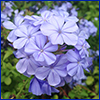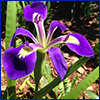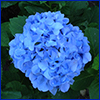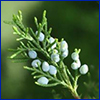Blue Flowers
Cool blue hues can help your garden become a calming and tranquil place. Of course, there aren't many "true blue" flowering plants to be found, but we’ve come up with a few that could help you bring on the blue.
 Plumbago is an easy-care plant which provides gardeners with delicate light-blue flowers. As an added bonus, plumbago is the larval host plant for the cassius blue butterfly. These shrubs bloom year-round in South and Central Florida unless hit by frost. In North Florida, plumbago flowers from spring to fall. Plumbago will be damaged by a freeze, but quickly recovers.
Plumbago is an easy-care plant which provides gardeners with delicate light-blue flowers. As an added bonus, plumbago is the larval host plant for the cassius blue butterfly. These shrubs bloom year-round in South and Central Florida unless hit by frost. In North Florida, plumbago flowers from spring to fall. Plumbago will be damaged by a freeze, but quickly recovers.
 Salvia guaranitica is one of the many blue salvias on the market. One great-performing cultivar is ‘Black and Blue’, which has deep blue blooms and black calyces from late spring to fall. This salvia has a mature height and spread of 3 to 4 feet. Learn more about salvias. (Photo: Gary Wade, University of Georgia, Bugwood.org)
Salvia guaranitica is one of the many blue salvias on the market. One great-performing cultivar is ‘Black and Blue’, which has deep blue blooms and black calyces from late spring to fall. This salvia has a mature height and spread of 3 to 4 feet. Learn more about salvias. (Photo: Gary Wade, University of Georgia, Bugwood.org)
 Blue flag iris is great for growing around water. This Florida native can grow in standing water, but will also tolerate normal garden soils if watered regularly. This truly blue-flowering plant is a perennial that grows two to four feet tall. Great for bringing blue to your garden in the spring, the deep-green leaves of this plant also provide architectural interest year-round.
Blue flag iris is great for growing around water. This Florida native can grow in standing water, but will also tolerate normal garden soils if watered regularly. This truly blue-flowering plant is a perennial that grows two to four feet tall. Great for bringing blue to your garden in the spring, the deep-green leaves of this plant also provide architectural interest year-round.
 Delphinium is a cool-season bedding plant that will give you a true blue flower. While grown elsewhere as a perennial, here in Florida we grow it as an annual. Beginning in March these plants produce attractive flower spikes that not only look great in your garden, they also hold up well in cut flower arrangements.
Delphinium is a cool-season bedding plant that will give you a true blue flower. While grown elsewhere as a perennial, here in Florida we grow it as an annual. Beginning in March these plants produce attractive flower spikes that not only look great in your garden, they also hold up well in cut flower arrangements.
 Hydrangeas are large shrubs with incredible blooms during the warmer months. Generally, the popular mophead and lacecap cultivars produce blue flowers. But not all hydrangeas are blue; other flower colors include white and ranges of pinks and purples. The plants must be grown in acidic soil in order to produce the blue color. Most soils in north and central Florida are slightly acid and thus most French hydrangea flowers are blue or purple.
Hydrangeas are large shrubs with incredible blooms during the warmer months. Generally, the popular mophead and lacecap cultivars produce blue flowers. But not all hydrangeas are blue; other flower colors include white and ranges of pinks and purples. The plants must be grown in acidic soil in order to produce the blue color. Most soils in north and central Florida are slightly acid and thus most French hydrangea flowers are blue or purple.
 For something a little more subtle than flowers, try blue berries. Female plants in the Juniper genus, like red cedar, produce light blue berries that attract birds (pictured). Gardeners in north and central Florida might try swamp dogwood (Cornus foemina), which produces indigo berries, or arrowwood (Viburnum dentatum), which produces dark blue fruit.
For something a little more subtle than flowers, try blue berries. Female plants in the Juniper genus, like red cedar, produce light blue berries that attract birds (pictured). Gardeners in north and central Florida might try swamp dogwood (Cornus foemina), which produces indigo berries, or arrowwood (Viburnum dentatum), which produces dark blue fruit.
Blue can sometimes be hard to see at a quick glance, but using it in your garden can be worth the effort. Plants featuring blue have a cool, soothing effect, and add a sense of depth to the landscape. With some well-placed "blue plants," you can add this beautiful color to your home.
Also on Gardening Solutions
- Blue Flag Iris
- Delphinium
- Hydrangea
- Plumbago
- Purple Plants
- Red Cedar
- Salvias
- Seeing Red: Flowers, Foliage, and Berries

